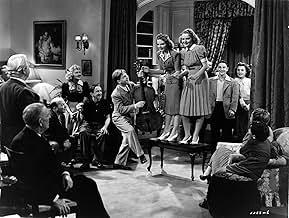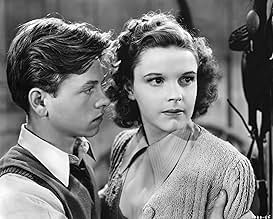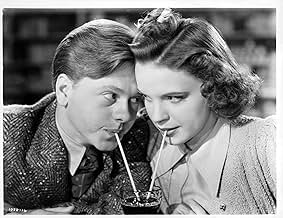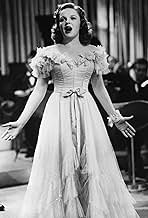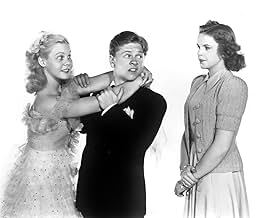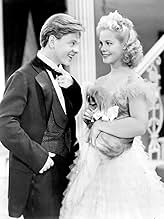Quando o show de variedades começa a ser substituído pela Broadway e pelo cinema, Mickey e Patsy, filhos de artistas de show de variedades, querem provar que têm talento para entrar no showb... Ler tudoQuando o show de variedades começa a ser substituído pela Broadway e pelo cinema, Mickey e Patsy, filhos de artistas de show de variedades, querem provar que têm talento para entrar no showbiz e garantir o sustento de suas famílias.Quando o show de variedades começa a ser substituído pela Broadway e pelo cinema, Mickey e Patsy, filhos de artistas de show de variedades, querem provar que têm talento para entrar no showbiz e garantir o sustento de suas famílias.
- Direção
- Roteiristas
- Artistas
- Indicado a 2 Oscars
- 2 vitórias e 2 indicações no total
- Bobs
- (as John Sheffield)
Avaliações em destaque
BABES IN ARMS was originally a Rogers and Hart show that proved a smash on the New York stage--a slightly satirical script with one of the most powerful scores of the 1930s. MGM specifically purchased the property for Rooney and Garland and then promptly threw out the script, most of the score, and transformed the thing into the tale of young teenagers who decide to put on a show in a barn.
Although well performed, the songs that replaced the original score simply do not measure up to the play's original score, and viewers are likely to be startled by a minstrel show number that finds Mickey and Judy romping in blackface. In justice to the film, it should be remembered that while minstrel shows remained popular well into the 1950s, and such great stars as Al Jolson and Eddie Cantor performed in full blackface well into the 1930s. While the number is stereotypical, it is not meanspirited, and if nothing else it offers a glimpse into a now dead theatrical tradition.
But weirdest of all is the grand finale "In God's Country," a strange mixture of Hollywood ballyhoo, patriotism, and fear of the European war that would soon engulf the world. In its original form, the number also included Rooney and Garland doing a take off of FDR and Eleanor; although cleverly performed and quite mild in content, this was later cut in re-release, for MGM worried it might be construed as disrespectful during wartime.
The film has a number of distinct flaws. Director Busby Berkley was most at home with big-budget musicals that had scope for the elaborate dance numbers he favored--he's something of a fish out of water with this more intimate material, and his approach feels heavy handed. Although much admired at the time (he actually received an Academy Award nomination for Best Actor for this film), Mickey Rooney's performance is absurdly manic by modern standards, and Garland's more natural performance is too often overshadowed by his excesses. The script is as weak as the score, few of the supporting performers are memorable (Margaret Hamilton is an exception), and the whole thing has a awkward quality to it.
Even so, it's still possible to see what all the fuss was about. The film does capture an inkling of the famous Rooney-Garland chemistry--a chemistry that would fuel three more "let's put on a show!" musicals, each one more more effective than the last. It is there in every musical number the two perform, in every line, in every scene, a very real and very powerful thing. While casual viewers would do better to select either BABES ON Broadway or GIRL CRAZY, in spite of all its flaws, Rooney-Garland fans will likely find BABES IN ARMS an essential.
Gary F. Taylor, aka GFT, Amazon Reviewer
What he and Judy do, they do better than anyone else, put on a show. In fact in this case the 'put on a show' gambit did originate in the original Broadway Musical. Babes in Arms was one of Richard Rodgers and Lorenz Hart's best shows it ran for 289 performances in the 1937 season and boasted such Rodgers&Hart classics as Johnny One Note, Way Out West, My Funny Valentine, I Wish I Were in Love Again all of which were discarded for the film. The Lady is a Tramp is only heard instrumentally, my guess is the Code frowned on that lyric. The title song and Where or When are retained. In fact when you come right down to it, only the basic idea the songs mentioned and a couple characters names came over from Broadway.
Still Nacio Herb Brown and Arthur Freed wrote Good Morning which is better known from Singin' in the Rain, but it was Judy and Mickey who introduced it here. And a whole lot of other Brown&Freed songs from MGM musicals got interpolated into the score.
Douglas MacPhail and Betty Jaynes who were introduced in Sweethearts also are here and sing beautifully. They married, but the marriage and MacPhail's career fell apart and he committed suicide a few years later. He had a great baritone voice, what a shame. The following year he introduced my favorite Cole Porter song, I Concentrate On You in The Broadway Melody of 1940.
This was the film Judy Garland did right after The Wizard of Oz and coming along right with her is Margaret Hamilton playing another Miss Gulch like character. One of those spinster ladies who forever pry into other people's business.
Believe it or not there was still a lot of prejudice against theatrical people even in 1937. A lot of old vaudeville types like Charles Winninger, Rooney's father in the film, settle in the town of Seaport on Long Island and their presence apparently upsets the ruling families like Hamilton's. When times go bad and vaudeville goes to seed, things get kind of rough for them. The old timers try to take a last tour to raise some money, but instead it's the kids who are up to the latest trends in pop music who save the day.
Guy Kibbee is in this also, playing against type as a wise and sympathetic judge, usually the parts MGM reserved for Lewis Stone or Lionel Barrymore. A more typical Kibbee type would be the oafish tycoon in 42nd Street, but he's fine here.
Possibly director Busby Berkeley wanted Kibbee, maybe as a good luck charm from that other breakthrough musical of his from his days at Warner Brothers. Of course the musical numbers in the show are set with the usual Berkeley surrealism, a little tempered though from his high flying days at Warner Brothers. That same year Berkeley had done a surreal type number in the Jeanette MacDonald-Lew Ayres film Broadway Serenade and it laid an egg. Someone at MGM must have reined him in.
Babes In Arms retains all its charms from 1939 mainly because Mickey Rooney is infectious and Judy Garland's singing is eternal.
P.S. Judy has a really cool dress in the finale.
Você sabia?
- CuriosidadesMGM Studio's biggest money grosser of 1939, surpassing O Mágico de Oz (1939) for that production year.
- Erros de gravaçãoDuring the girls' duet, Patsy Barton begins her solo, and Mickey Moran switches from cello plucking to piano thumping. However, the music continues as it was before, and we don't hear any amazing sounds on the piano in spite of Mickey's efforts.
- Citações
Mickey Moran: [singing] Here we are together, a couple of stayer-uppers / Our day is done at breakfast time and starts it with our suppers / Here we are together, ah, but the best of friends must part-y / So let me sing this parting song from the bottom of my heart-y.
- Versões alternativasOlder TV prints (and early video releases) of "Babes In Arms" run 91 minutes, and exclude the "My Day" segment of the finale, with Mickey Rooney and Judy Garland spoofing Franklin and Eleanor Roosevelt. This segment was deleted for a 1948 reissue. "My Day" was restored in the 1990's by Ted Turner, and is included in current prints.
- ConexõesEdited into Hollywood: The Dream Factory (1972)
- Trilhas sonorasBabes in Arms
(1937)
Music by Richard Rodgers
Lyrics by Lorenz Hart
Played during the opening credits
Sung by Douglas McPhail (uncredited), Mickey Rooney (uncredited), Judy Garland (uncredited) and chorus
Principais escolhas
- How long is Babes in Arms?Fornecido pela Alexa
Detalhes
- Data de lançamento
- País de origem
- Idioma
- Também conhecido como
- Los hijos de la farándula
- Locações de filme
- Empresa de produção
- Consulte mais créditos da empresa na IMDbPro
Bilheteria
- Orçamento
- US$ 748.000 (estimativa)
- Tempo de duração
- 1 h 34 min(94 min)
- Cor
- Proporção
- 1.37 : 1


